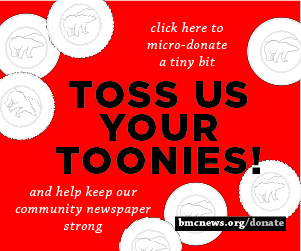Backyard Composting
The beauty of composting is that, basically, you get something wonderful (better soil for your garden), in exchange for almost nothing (kitchen scraps, shredded paper, grass clippings, fall leaves). There’s another benefit too – less waste to be hauled away on garbage day, but for the purpose of this article that’s a secondary benefit. Here we’ll focus on how Boyle Street and McCauley residents can turn much of their garbage into nutrient-rich, natural soil conditioner and fertilizer. If you want to grow your own vegetables, create a flower garden that blooms all summer, or have the greenest, healthiest lawn on your block – compost is the key.
Compost is what happens when organic matter (such as plants) rots or decays. The biological process is complex – picture a miniature factory of bacteria and other microorganisms quietly working away 24/7. But, you don’t really need to know the science. Just remember that composting requires four main “ingredients”:
1. Greens (for nitrogen). Greens include any kind of fruit or vegetable, coffee grounds, or grass clippings.
2. Browns (for carbon). Browns include dead leaves, shredded paper, sawdust, or pine cones.
Ideally, compost should be about half greens and half browns. The other two key ingredients are:
3. Air
4. Water
These last two are needed to “heat up” the compost and speed decomposition.
Now that you know the basic compost recipe, all you need to get started are a few supplies:
- A container with lid to collect kitchen scraps and other compostable materials. A plastic ice cream tub will do admirably. Or use a smaller, yogurt-size container that you can keep in the fridge, then empty it into a larger container kept outside the back door.
- A shovel or pitchfork to mix or turn your compost, and later to dig it into your garden.
- A garden rake – if you want to spread compost as a lawn fertilizer.
- A piece of dowel (such as an old broom handle), a stick, or pipe to aerate the compost pile.
- A wire mesh screen to filter finished compost.
- An outdoor compost bin. This can be just a simple compost pile in the corner of your yard, or a pit, but a bin looks tidier. If possible, place your compost bin in a sunny, convenient spot. Many types of bins are available for sale, but homemade bins, made from scrap materials, such as shipping pallets, work just as well – if not better.
In your compost bin you can put:
- Any type of vegetable or fruit scraps or peelings, or rotting vegetables.
- Egg shells.
- Used paper towel, shredded newspaper, sawdust.
- Coffee grounds (the paper filters are OK too), and tea leaves or bags.
- Grass clippings (or just leave these on your lawn to enrich it and keep moisture in).
- Pine cones and small sticks (these can help create more air in your compost pile).
You can even throw in pet or human hair, and lint from your clothes dryer! But, don’t put any meat, fish, oils, dairy, or pet wastes in your compost – these can introduce toxins, attract pests, or make your compost heap smell bad. A well-functioning compost heap does not smell and the heat produced by the breakdown of organic matter keeps pests away.
The beauty of composting is that, basically, you get something wonderful (better soil for your garden), in exchange for almost nothing (kitchen scraps, shredded paper, grass clippings, fall leaves).
When you put your greens (vegetable scraps, etc.) in your compost bin cover them with about the same amount of browns (dry leaves, soil, etc.). Make sure the compost is kept moist (about the consistency of a damp, wrung out sponge). Use the dowel or stick to poke holes to aerate the pile. Mix or turn the compost every few weeks during the summer.
Within a month or two you’ll be able to start screening out the finished compost and spreading it on your lawn or garden beds. You can compost year round – though the compost pile may be dormant in winter – just keep the greens covered with layers of fall leaves and you’ll have a head start when spring comes around.
If you have questions about composting call the City of Edmonton Waste Hotline at (780) 496-5698, e-mail: MCRP@edmonton.ca, or check the web site for more information and upcoming composting workshops: www.edmonton.ca/compost.
Leigh-Ann Topfer is a novice composter and a graduate of the 2011 City of Edmonton Master Composter Recycler Program.






